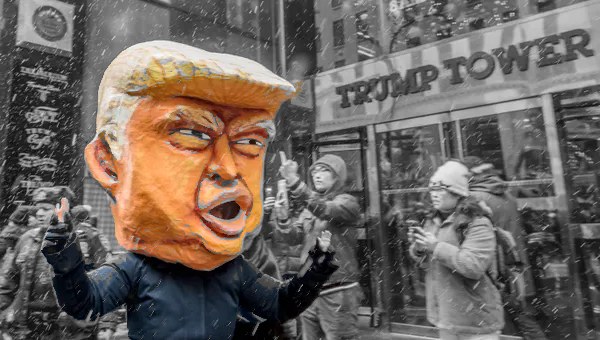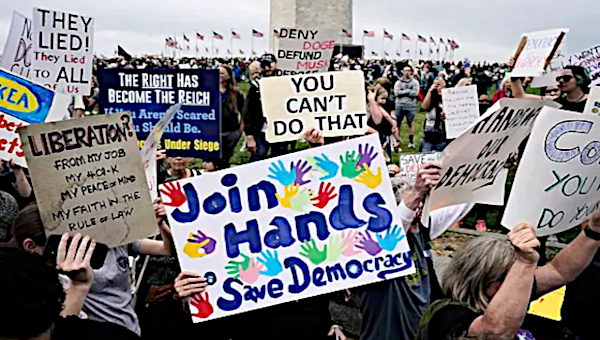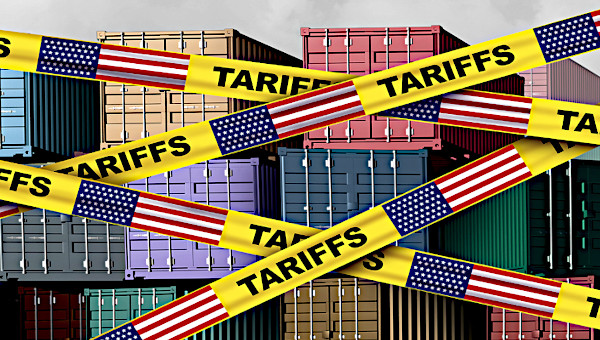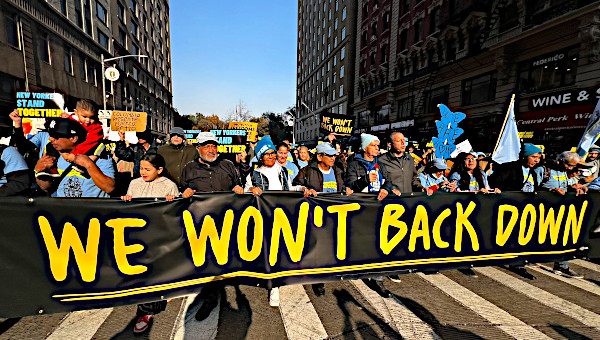Donald Trump: Emperor of the Lumpen Proletariat or the Stalin of Capitalist Counter-Revolution?
Donald Trump defies easy classification. His location within the politics of class eludes precise definition. If there is no doubt that he functions in the interests of capital, his capacity to not only expose but also exacerbate the fraction-ridden nature of this highly differentiated entity and the state that oversees its collective interests is unprecedented.

Trump’s willingness to openly espouse the racism, national chauvinism, anti-semitism, and misogyny that runs rampant in ruling class circles is, among those who have attained the presidency, unique in modern times. His conscious use of this reactionary arsenal in appeals to a mobilized mass base of marginalized and often downwardly mobile people may well deflect attention away from those whose interests he routinely serves. They occupy positions in the American class hierarchy far removed from the dispossessed.
Obfuscating Trump’s class politics is his jettisoning of the conventional concern most political leaders within bourgeois democracies exhibit in not wanting to appear crassly self-interested. In this he shares more with the dictators he admires than many of the politicians who have aspired to and achieved the American presidency in the post-World War II years. Shameless and self-centred to the point of a narcissistic inability to grasp that he alone is not the centre of a universe of power (that an individual is not the state!), Trump’s purpose of advancing his accumulative interests and holding firmly to any and all authority he has amassed is transparent beyond boundaries of past belief. Combined with a jarring, but now routinized, erraticism, this makes for difficulty in pegging Trump to a consistent class politics. Yet such a politics does, of course, exist.
Trump’s Class Politics
If it has any consistency and coherence, Trump’s politics of class turns on tax cuts; consolidating the hegemony of Wall Street, not only as speculative haven of free-wheeling capital, but as arbiter of the economic well-being of the nation; promoting deregulation so as to liberate commercial power from the constraints of state intervention; securing Supreme Court appointees that will frame law in ways that privilege individual entitlements over collective responsibilities, with the notable exception of a woman’s right to choose; and making America, as a white nation, great again, which centers on symbolism such as Trump’s laughable Wall and trade and tariff policies that will supposedly bring jobs back to the United States industrial heartland.
The first planks in this agenda have been somewhat successful, winning Trump the support of the most belligerent wing of free-marketeering capital. With respect to the trappings of a racist assault on immigrants, be they Mexicans or Muslims, diatribes on the sanctity of borders, and the need to protect United States citizens from desperadoes, dope, and dangerous job-stealing aliens resonate with sectors of the white, marginalized poor. Yet the foundational plank of Trumpism, the attempt to revive the Rust Belt and kick-start an economy collapsing in the throes of deindustrialization, has been a decided bust. Statistics of “job creation” are the truly fake news of our times, with employment numbers cooked to good effect at the same time as they conceal the extent to which the work sectors that have grown are poorly paid and precarious, anything but a substitute for the relatively well-remunerated, secure, union labour that disappears daily.
Clyde W. Barrow keys on this latter failure in his suggestion that Trump’s 2016 election can be understood as the rise of a Prince and possible future Emperor of the lumpen proletariat. (See The Bullet, No. 2180, 30 August 2020.) It is an intriguing claim, based on one of Karl Marx’s more metaphorically-poised writings, the literary masterpiece, The Eighteenth Brumaire of Louis Bonaparte (1852). Rich in classical allusions, and driven by Marx’s profound disappointment, frustration, and anger at the failures of the 1848 Revolution, the essay is an exploration of how, at a specific historical conjuncture, “a grotesque mediocrity,” Charles-Louis Napoléon Bonaparte, occupied centre stage in the bourgeois politics of France, overseeing a government of “hommes entretenus.” His path to power supposedly paved by his leadership of the lumpen proletariat, Bonaparte, according to Marx (who has been challenged on this score1), rallied this societal contingent, the “scum, offal, refuse of all classes,” as the basis of his regime of petty knavery. His constituents, like their leader, followed a course of “benefitting themselves at the expense of the labouring nation.”
There is much in The Eighteenth Brumaire, as Barrows insists insightfully, that translates easily into an assessment of Donald Trump. Consider the conclusion to the essay:
“Driven by the contradictory demands of his situation and being at the same time, like a conjurer, under the necessity of keeping the public gaze fixed on himself, as Napoléon’s substitute, by springing constant surprises, that is to say, under the necessity of executing a coup d’état en miniature every day, Bonaparte throws the entire bourgeois economy into confusion, violates everything that seemed inviolable to the Revolution of 1848, makes some tolerant of revolution, others desirous of revolution, and produces actual anarchy in the name of order, while at the same time stripping its halo from the entire state machine, profanes it and makes it at once loathsome and ridiculous.”
As a statement of what Trump has done in his time in office, this is not far off the mark. And there are many other parallels between Trump and Bonaparte: “No one has ever sacked lackeys with less ceremony than Bonaparte his ministers”; “He behaved like unrecognized genius, whom all the world takes for a simpleton.”
American Lumpen Proletariat
Yet I am not convinced that presenting Trump, as Marx does Charles-Louis Napoléon Bonaparte, as the chief of a declassé lumpen proletariat, their Emperor brought to power and domination, is useful. The entire question of the lumpen proletariat is much debated among Marxists, and Marx and Engels themselves offered different assessments of its historical potential in different circumstances.2 This is hardly surprising, given that the lumpen proletariat constitutes a highly volatile, differentiated, and politically unstable social stratum. No doubt Barrow’s new book will contribute much to this discussion.
How and why Barrow sees the American lumpen proletariat of Trump’s time gravitating to a grotesque pretender is no doubt important in any discussion of the current political conjuncture. Recurrent capitalist crises have morphed into a restructuring of modern political economy that has left larger swaths of working people either perpetually unemployed or dependent on increasingly precarious, poorly paid, and casualized employments. Barrow regards this as the lumpenization of the white, male proletariat, but he perhaps too easily identifies the working class with secure, well-paid employments. Historically, the proletariat has, aside from a brief period of relative security in the advanced capitalist Fordist economies of the 1945-1975 years, always existed precariously. Even during this three-decade highwater mark of supposed affluence and proletarian well-being, the promise of working-class security was often more ideological posture than an accurate representation of the actualities of labouring life, as critical commentaries of the myth of the happy worker made clear.3
As appropriate as it is to confront the conditions of dispossession within working class life, Barrow’s approach may have succumbed to conventional wisdoms that see the jobless and decimated male white working class, now faltering on the ruins of sectors of the United States economy – coal, textiles, automobiles — as the mass base of a debased imperial presidency. Mike Davis has offered an insightful rejoinder to this narrative of false consciousness, acknowledging, of course, that plant closures and economic malaise did indeed play a part in structuring Rust Belt voting in 2016. But Trump’s victory rested on far more than the discontents of the malignant dispossessed, however much some in this growing stratum were willing to become, as Marx wrote of the lumpen proletariat bolstering Charles-Louis Napoléon, “bribed tools of reactionary intrigue.” As one British journalist reported in November 2016: “At over a dozen Trump rallies, in almost as many states, your correspondent has met lawyers, estate agents, and a horde of middle-class pensioners – and relatively few blue collar workers.”4 As exit polls in the last election showed, it was only among relatively low-income earners that Hillary Clinton outpolled Trump. Among the lowest of earners – those whose income was less than $30,000 annually – the advantage of the Democratic candidate over her so-called Republican rival was a whopping 53-41 percent. In every category of income above $50,000 annually Trump won a plurality, albeit narrowly.
Indeed, as much as it is possible to see lumpen elements rallying to Trump’s sordid side, to the extent that bribes are solidifying his support, they are surely not going to an “underclass” of an Ozark amphetamine economy or the Oakland chapter of the Hell’s Angels, let alone jobless inner-city youth. Even the proto-fascist, paramilitary “guards” that have sprung up, mushroom-like, under the lush growth of COVID-19 animosity to the state’s infringement on America’s peculiarly rabid fetishization of individual freedom, are not really feeding off the crumbs from Trump’s table as much as they are throwing the currently-threatened right to bear arms into the chaotic mix of politics and protest at the level of the street.
As Trump tweets encouragement of these forces to “liberate” states and urban cores ostensibly held hostage to so-called “outside agitators and anarchists” and the mayhem they inflict, those bought off by his Administration in a big way are not those marching on capitol buildings or riding shotgun into the riotous night. Rather, the obvious beneficiaries of the bribes Trump offers are the Devoses and the DeJoys, on the one hand, and the Manaforts and Arpaios, on the other. Figures like the “toxic,” “kill anything that moves” Navy Seal, Eddie Gallagher, don’t quite classify as lumpen proletarians, their starched white uniforms and neatly clipped hair hardly the garb of the truly downtrodden. Trump granted clemency to Gallagher after his conviction for staging a posed photograph of himself and the body of a dead Islamic State captive, a teenager he had killed with a hunting knife. (Gallagher also shot a schoolgirl and an elderly man from a sniper’s post, acts of “bravery” Trump applauds.) Enjoying his new found freedom at Mar-a-Lago, Gallagher and his wife holidayed at the Florida resort, the guests of Donald and Melania Trump.
The Trump-touting night riders who recently drove from the suburbs of Portland, Oregon to do battle with downtown protesters, firing volleys of paint balls into their midst and brandishing assault weapons, no doubt constituted an armed militia, but their trucks and vans were not the material stuff of Marx’s mid-19-century “decayed roués with dubious means of subsistence and of dubious origin, … ruined and adventurous offshoots of the bourgeoisie, … vagabonds, discharged soldiers [well, maybe a few of these were there, BP ed], discharged jailbirds, escaped galley slaves, swindlers, mountebanks, lazzaroni, pickpockets, tricksters, gamblers, maquereaus, brothel keepers, porters, literati, organ-grinders, rag-pikers, knife-grinders, tinkers, beggars – in short the whole indefinite, disintegrated mass, thrown hither and thither … ” In sum, not exactly the human make-up of the Patriot Prayer crowd. No doubt the votes of discontented, jobless white workers in states like Ohio, Pennsylvania, Michigan, and Wisconsin helped secure Trump his 2016 victory, but are such supporters of Make America Great Again [MAGA] any more lumpen than the destitute inner-city poor of New Orleans, Chicago, New York, or Los Angeles, for whom Trump is anathema?
Barrow’s focus on an undifferentiated lumpen is unlikely to explain much about who will rally to Trump and who will not. Marx, after all, always insisted that it was elements of the lumpen proletariat that would gravitate to reaction, while others in this unstable stratum could well be won to the politics of proletarian insurgency. In the United States of 2020, race and the venom of white supremacy cut through the class formation of a modern-day lumpen proletariat aligning the thought and activities of the destitute in jarringly oppositional ways.
Will the dispossessed of Kenosha, Wisconsin, which saw a decisive 25% electoral swing away from Obama to Trump, a clear protest against having to opt for a despised and distant Hillary Clinton in 2016, stay with Trump in 2020, after recent events. Maybe. But it was not the lumpen of Kenosha, let alone the city’s unemployed auto workers, who recently expressed a love of Trump, the Chief of Police and the association representing his gendarmes opting for that endorsement. The reinvigoration of Black Lives Matter, after all, was precipitated by the death of George Floyd who, in class terms, probably conforms as much to a stereotypical lumpen proletarian as does the 17-year old armed Trumpite who killed and maimed protesters in Kenosha, Kyle Rittenhouse. But while Mr. Floyd is dead, and mourned in massive mobilizations of resistance to the business of racism unfolding as usual, Rittenhouse is now supported and defended by Sunbelt millionaires and powerful reactionary ideologues in the legal community of arch-conservatism.
All of this, moreover, is to look at Trump’s support and his electoral success from the bottom up. From the top down, the gerrymandering of voting districts and the suppression of the franchise exercised by the propertyless poor, many of them black and brown, will likely figure as forcefully in the outcome on 3 November 2020 as any lumpen proletarian Trumpist vanguard. As will the dark money of the Koch Brothers and their ilk or, in the event of a contested outcome, the reconstruction of the Supreme Court.
Tragedy and Farce
At the time I read Barrow’s presentation of Trump as the Prince/Emperor of the lumpen proletariat I was rereading Leon Trotsky’s Stalin: An Appraisal of the Man and His Influence (1946). Published posthumously, this unfinished assessment of Stalin first appeared in a distorted translation by Charles Malamuth, whose editorial adulterations for the commercial house, Harper & Brothers, shortened the text considerably, and altered Trotsky’s understandings with additions of passages not written by the founder of the Left Opposition. This elicited protests from his widow, Natalia Sedova, and his legal counsel, Albert Goldman. Fortunately, Alan Woods and the International Marxist Tendency republished a new edition of Stalin, retranslating the entire book. The result is, in spite of understandable repetition that Trotsky would undoubtedly have eliminated had he lived to finish and polish the manuscript, an extraordinary appraisal of Stalin, one that, like The Eighteenth Brumaire, offers many parallels relating to Trump.5
To draw attention to this is not to suggest that Stalin and Trump are in some ways the same. Rather, it is to point out that their historic significance bears similarities, in the same way that Marx’s elaborations on the 1848-1852 years point to correspondences between a long-ago past and our current present. A genuine and world historic Revolution brought Stalin to power and allowed him to consolidate the capacity to undermine that very same revolutionary accomplishment. As Marx would note in The Eighteenth Brumaire, however, a Hegelian appreciation of how “facts and personages of great importance in world history occur, as it were, twice,” needs to be analytically situated on understanding that this repetition occurs “the first time as tragedy, the second as farce.” If Stalin’s counter-revolutionary Thermidor was indeed tragic, Trump’s farcical Presidency, preceded and in some ways secured by the so-called Reagan Revolution and its ideological assault on Keynesian economics, dismantling of the regulatory and welfare states, reification of the market as the defining structure of everyday life, and realignment of electoral constituencies, is capable of producing some truly tragic outcomes. One of these is the mounting death toll and jaw-dropping consequences of the shut-down of the United States economy amidst the COVID-19 pandemic.
Like Stalin, however, Trump may well, given his erratic and narcissistic regime, blow up the ‘revolutionary’ foundations laid by predecessors, which prepared the ground Trump is now willing to slash and burn. Unlike Stalin, however, Trump has neither the solid rooting in the conditions that brought him to power, nor the likely longevity that is required to sustain authority over decades. Stalin’s destructive rule lasted so long precisely because he was identified with the popular consequences of the 1917 Revolution; managed to align his apparatus of governance with the legacies of Lenin, however perverted this ideological congealment; consolidated a state and party apparatus that included security forces and the Red Army; and stood atop the planned economy’s heroic mobilization against fascism. All of this allowed Stalin to both vanquish opponents and cultivate the persona of the Soviet people’s resolute, and great, leader. Yet his leadership stood diametrically opposed to that of those, like Lenin and Trotsky, who led the struggle to create the world’s first workers’ state. Born of revolution, Stalin sustained counter-revolution. He repudiated the possibility of world revolution in his retreat into a dogma of socialism in one country, consolidating a tyrannical regime that, by the time of the Moscow Trials of 1937-1938, had liquidated the entire corps of revolutionary Bolsheviks that defeated czarist autocracy and laid the foundations of a possible socialist society.
Trump, compared to Stalin, is a farce precisely because he lacks anything that could remotely compare to the historic experience that gave rise to Stalin and that Stalin ultimately perverted. The Trumpist slogan ‘Capitalism in One Country’ does not have quite the unique and galvanizing potential to rally adherents as did Stalin’s ‘Socialism in One Country’. This does not, unfortunately, necessarily weaken Trump’s ability to influence an historical turn to the tragic. For Trump’s volatility unleashes a capriciousness that could well implode in ways that blow open the Pandora’s Box of late capitalism’s destructiveness. Stalin and Trump share what Trotsky designated the former’s “almost unerring instinct” to raise “the art of manipulating personal or group antagonisms to new heights.” But in Trump’s case this comes with a cost to the pretensions of bourgeois democracy, appeals to all manner of unsavoury “fine people” types raising the spectre of wars of attrition. As the mainstream conservative Republicans associated with the Lincoln Project know all too well, Trump actually threatens what they cherish and wish to continue: the reactionary promise of neoliberalism, governance by austerity, and suppression of any and all oppositional challenges mounted by organized labour and coalitions of all manner of minorities demanding not the curbing of liberal entitlements but their expansion. It is not that Trump opposes any of this, which he does not, but that his blatant pursuit of his self-interest, cynical refusal to play by any rules, and willingness to precipitate the American political economy into endless chaos, exposes the conservative project to ridicule and foments a counterproductive instability.
Trump and Stalin, both in their own ways, and in their highly different circumstances and timetables of possibility, have and are now in the process of devouring, not their young, but their elders, those who created the conditions that brought these two agents of destruction to power. The young will be ravished later. If Stalin, in Trotsky’s assessment, cultivated the bureaucratic apparatus that constituted “the first stage of bourgeois restoration,” Trump’s unpredictability and governance by disorder may well, if allowed to continue, topple capitalism’s post-1973 counter revolution. It is not the supposed ‘socialists’ of the Democratic Party opposition that significant elements of the ruling class fear at the moment, for they can rest assured that a Biden-Harris leadership will nip any ‘progressive’ alternative in the bud, as indeed they are doing right now. Nor does the ruling class quake in its billionaire boots at the threats raised by the militants of an Antifa anarchist mobilization. Rather, it is the more generic anarchy of a White House Administration lurching from one episodic scandal and politically rudderless crisis to the next that has become increasingly worrisome.
Few would have predicted that either Stalin or Trump would climb the heights they managed to ascend. Lenin’s suppressed “Last Testament,” written during an illness in two installments in December 1922 and January 1923, summarized the Bolshevik leader’s serious misgivings concerning Stalin’s leadership of Russian Communists. Stalin’s personal failings, identified by Lenin as rudeness, intolerance, and an unseemly willingness to exercise unlimited authority incautiously were intolerable in a leader of a nascent revolutionary state, and Lenin called on his old Bolshevik comrades to, in effect, depose Stalin. As Trotsky’s Stalin makes abundantly clear, his nemesis was an intellectual mediocrity and a bit-player in the making of the 1917 Revolution, but he was gifted with “will-power and ambition … [, a] firmness of character, slyness, narrowness of outlook, and ruthlessness toward opponents.” Such characterizations apply to Trump as well, as any number of pre-2016 election commentaries on the part of mainstream Republicans make abundantly clear. Even in power, and with his base firm in its support, Trump is ill-tempered because he knows he walks among truly fair-weather friends, his White House aides and would-be handlers an endless source of leaks and calculated clandestine complaint. Trotsky noted of Stalin’s early days in a position of authority that he walked “through the Kremlin sulking, like Ivan the Terrible… Stalin is not loved even by his immediate entourage.” Trump, wandering the White House halls late into his lonely, twitter-fed, evenings, is portrayed similarly by journalists privy to the unattributed confessions of the Administration’s hirelings.
Consider three ways in which the practices of Trump and Stalin converge.
1. “I’ll choose the best people for my administration.”
Donald Trump, September 2016.
One way in which both Stalin and Trump rationalized their rise to power was to deflect criticism of their obvious defects and seeming unsuitability for leading their respective societies. They promised they would surround themselves with available ability and talent. Having consolidated a bureaucratic caste by 1929, Stalin nonetheless assured those inquiring as to the state of his administration that in the early 1930s it contained “our best industrialists, our best co-operators, our best military men, our best propagandists, our best agitators, our best experts on Soviet farms, our best experts on collective farms, our best experts of individual peasant economy, our best experts on the nationalities of the Soviet Union and of national politics.” Within less than a decade, Stalin had liquidated all of these experts, the “best people” being either arrested, railroaded to the Gulag, or executed. Trump’s best people have fared better, although they have not been spared the humiliations of their superior’s demands they pass repeated loyalty tests. Failure on this front is not countenanced. Freed from facing the firing squad, many have simply been ignominiously fired. “All that Stalin needed was an excuse or a suitable political aim in order to exterminate them and revenge himself on them for his mediocrity,” concluded Trotsky in a passage that, if stripped of its reference to physically eliminating administrators, seems to sum up something of Trump’s relation to expertise.
2. “There has never been, ever before, an administration that’s been so open and transparent.”
Donald Trump, May 2019.
Trump’s White House transparency, of course, is built on the sands of lies, distortions, and statements calculated to deflect and misdirect. As of July 2020, the Washington Post calculated that the President had made more than 20,000 false or misleading claims. It is an axiom of our times that politicians lie, inuring us to the view that this deceit is a right of passage in the corridors of state power, an instinctual recourse to falsehood being something of an occupational hazard of the electoral system’s representatives.
Stalin’s lies, and the carnage they sustained, would be difficult to duplicate, and Trump’s willingness to stretch truth well past any reasonable breaking point is of an entirely different, less consequential, magnitude. Nonetheless, Trotsky’s comment on Stalin seems a solid fit with Trump’s perversions of speaking honestly: “… at each stage his lie serves his purpose at a given moment. He is not embarrassed by events concerning yesterday or tomorrow; he calculates on the short memory of the majority and on the physical impossibility of the minority publicly refuting [his false statements].”
3. “I’m a very stable genius.”
Donald Trump, July 2018.
The pathologies of Stalin and Trump converge in their narcissism. As laughable as it may be, both men were/are consumed with promoting themselves as stellar intellects. Trump’s pathetic accounts of his brilliant capacity to master a basic cognitive test – although some have suggested he almost certainly failed it – and his astounding willingness to proclaim himself a “stable genius” to a gathering of reporters was preceded by Stalin’s like-minded insistence on those around him recognizing his brilliance. For both Stalin and Trump there have been many willing to bow and scrape before them, the kind of human material Trotsky referred to as “accidental and second-rate people who have mastered the art of bureaucratic manoeuvering.” But among at least some of the older Bolsheviks having long acquaintance with Stalin, there were those who were incredulous. One dissident proclaimed to another revolutionary: “He wants me to consider him a ‘genius’!” Another, ensconced within Stalin’s inner circle, declared, “I am doing everything he has asked me to do, but it is not enough for him. He wants me to admit that he is a genius.”
 Trotsky thought Stalin’s pretensions coincided with the needs of a ruling caste which had “broken from the people” and required a “Bonapartist superman and infallible demigod as its crowning representative.” Trump has been unable, not for lack of trying, to consolidate such a caste, his family and a cohort of flunkeys substituting for it. The elected Republican Senators, a craven lot to be sure, have the trappings of such a political caste. But they are too beholden to the electoral process to truly constitute a permanent strata of support, which is best established in state bureaucracies that Trump does his best to knock off balance. As decisive as this failing to consolidate a bureaucratic caste is, it has not lessened the velocity and podium confidence with which Trump proclaims that only he can right the ship of innovative capitalism and Make America Great Again. This rivals Stalin for audaciousness.
Trotsky thought Stalin’s pretensions coincided with the needs of a ruling caste which had “broken from the people” and required a “Bonapartist superman and infallible demigod as its crowning representative.” Trump has been unable, not for lack of trying, to consolidate such a caste, his family and a cohort of flunkeys substituting for it. The elected Republican Senators, a craven lot to be sure, have the trappings of such a political caste. But they are too beholden to the electoral process to truly constitute a permanent strata of support, which is best established in state bureaucracies that Trump does his best to knock off balance. As decisive as this failing to consolidate a bureaucratic caste is, it has not lessened the velocity and podium confidence with which Trump proclaims that only he can right the ship of innovative capitalism and Make America Great Again. This rivals Stalin for audaciousness.
Petty Tyrants
None of this may mean very much. It confirms the obvious: autocratic leaders behave despotically, and bourgeois democracy can give us petty tyrants as readily as a degenerating workers’ state. If I am suspicious of attempts to locate Trump’s power, like Bonaparte’s, in the lumpen proletariat, one part of my skepticism lies in a recognition that for every contingent of Boogaloo Boys rampaging for Trump, there is a billionaire salting away mounds of cash and hundreds of lawyers, accountants, hedge fund brokers, and shopkeepers buying into the devil’s bargain on offer. These latter forces are more decisive in sustaining Trump – and the alt-right, as Steve Bannon makes abundantly clear – than the more clearly lumpenized shock troops who will undoubtedly continue to don MAGA hats and extend the politics of fear and hate. Trump’s ultimate significance is that he is willing to blow up the Constitution, the Presidency, the American economy, and a swath of the United States population, crossing class lines and ideological markers of separation to do so. If this recklessness attracts elements at the very bottom of the American class pyramid, this is because the lumpen proletariat has always contained those who will gravitate to extremist expressions of political mobilization.
What Trump could well detonate is hardly the sacred tablet of American exceptionalism that many champion, including a significant sector of the self-proclaimed left. The much-vaunted constitutional safeguards that he violates daily have been a dead-letter as far as the well-being of the vast majority of people in the United States have been concerned, and this has been the case for generations. Those who treasure the trappings of bourgeois democracy, and hold sacrosanct the symbolism of the People’s White House that Trump deploys in crass political manipulation, might reflect on the men and women who have sat in that edifice and carried out a multitude of crimes against humanity, not just domestically, but internationally. Their ranks would include Kissinger and Nixon, of course, but before them were Kennedy-and-Johnson-orchestrated adventures like the Bay of Pigs fiasco or even more murderous campaigns, including the imperialist carnage of the Vietnam War. Later Administrations, like those of the two Bushes, Reagan, Clinton, and even Obama, have much to atone for. Trump is awful, and there is no denying this, as even Republicans with a modicum of conscience are now acknowledging. But conservatives like Colin Powell, John McCain, and Mitt Romney broke with Trump only reluctantly, their preservationist instincts holding firm to “principles” that would leave the rich richer, the poor as maligned, marginalized, and maltreated as ever, and the world subject to the coercions of American capitalist might. The Lincoln Project critics of Trumpism know this well.
The question is: are the Democrats with Biden-Harris at their head the answer. The fear that four more years of Trump will end the American capitalist experiment as we know it is premised on understandings of what stands to be lost. Prospects are good that with a Trump victory we will continue to see deepening racial antagonisms; a retreat from the reforms gained in over a century of struggle around civil and labour rights, women’s emancipation, and a host of other important concerns, including LGBTQ entitlements; as well as dismantling the welfare state and abandoning the planet to environmental banditry. There are troubling indications of what lies ahead, with Supreme Court appointees rushed into the fray, all too ready to overturn women’s right to choose and scuttle any and all supports to entitlement to decent healthcare. Police executions of protesters suspected of killing right wing vigilantes, however much their own safety was threatened, are not only defended by Trump, but justified as necessary “retribution.” Trump’s dirty trickster, Roger Stone, is calling for insurrection if his padrone is defeated at the polls. There are of course segments of the lumpen proletariat ready to rally to this modern-day call to the barricades, but those bankrolling and benefitting from this brawl, calling the shots in its anarchic unfolding, are a bawdy plutocracy.
This is all very bad news. It stampedes what is left of the left into the arms of the mainstream Democratic Party. Sadly, however, while the continuity of the American capitalist enterprise under Biden and Harris promises some immediate relief from this nightmare of Trumpism, it postpones Armageddon rather than reverses our march toward it. Under the barely distinguishable banner of Build America Back Better, Biden-Harris offer, at best, a mildly social democratic alternative to Trump’s Make America Great Again, as toothless in its opposition as it is tepid in its political incapacity to boil the contemporary pot of class relations. To be sure, the Biden-Harris oratory of inclusion champions change. The virtues of trade unionism are extolled, albeit in circumstances where the labour movement has been largely neutered. A commitment to racial healing and social justice fairness is proclaimed, but the economic supports needed to actually implement this good intention are both only vaguely alluded to and unlikely to be realized. The plague of our time, COVID-19, will undoubtedly be addressed with more science and less hydroxychloroquine hype; there will be masks and there will be social distancing. But without a national healthcare program of the kind Bernie Sanders demanded, and which Biden-Harris refuse, how can any pandemic be fought to a standstill?
Trump’s ultimate farce – in decrying Biden-Harris a dangerous socialism – may well prove tragic in its own right. With substantive left alternatives abandoned in the rush to derail Trump’s impending train wreck, the course leading to barbarism, for all of the Biden-Harris claim that they will build better, is not going to be turned back. A nicer, more humane, but still exploitative, crisis-ridden, capitalism, around which many leftists are apparently now rallying, can never, in any final analysis, be the answer. •
Endnotes
- See, for instance, Marcel van der Linden, Workers of the World: Essays toward a Global Labor History (Leiden and Boston: Brill, 2018), 10, 21-27, 267, 298; Frank Bovenkerk, “The Rehabilitation of the Rabble: How and Why Marx and Engels Wrongly Depicted the Lumpenproletariat as a Reactionary Force,” The Netherlands Journal of Sociology, 20 (No. 1, 1984), 13-41; Pierre Caspard, “Aspects de la lute des classes en 1848: le recruitment de la Garde nationale mobile,” Revue Historique, 511 (July 1974), 81-106; Charles Tilly and Lynn H. Lees, “The People of June, 1848,” in Roger Price, ed., Revolution and Reaction: 1848 and the Second French Republic (New York: Harper and Row, 1975), 170-209.
- See, for one explication, Peter Hayes, “Utopia and the Lumpenproletariat: Marx’s Reasoning in The Eighteenth Brumaire of Louis Bonaparte,” Review of Politics, 50 (Summer 1988), 445-465.
- See, for instance, Michael Denning, “Wageless Life,” New Left Review, 66 (November-December 2010), 79-87; Bryan D. Palmer, “Reconsiderations of Class: precariousness as proletarianization,” in Leo Panitch, Greg Albo, and Vivek Chibber, eds., Socialist Register, 2014: Registering Class (London: Merlin, 2013), 40-62; Harvey Swados, “The Myth of the Happy Worker,” The Nation, 17 August 1957, 65-67.
- Mike Davis, “The Great God Trump and the White Working Class,” Catalyst, 1 (Spring 2017), esp. 166-167, quoting The Economist, 5 November 2016.
- Leon Trotsky, Stalin: An Appraisal of the Man and His Influence, edited and translated by Alan Woods (London: Wellred Books, 2016).





